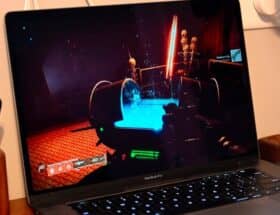Apple Vision Pro can shoot spatial video
 0 Facebook x.com Reddit
0 Facebook x.com Reddit
Apple has given users two options for capturing 3D “spatial videos”, Apple Vision Pro and iPhone 15 Pro, but both options have their drawbacks. Here's what you need to know.
There are many differences in the camera capabilities of the Apple Vision Pro and the iPhone 15 Pro. In addition to technical characteristics, the size and form factor of the devices change the shooting capabilities and their practicality.
The most significant disadvantage that Apple Vision Pro users will face is public acceptance. It won't be easy to convince your loved ones to act natural while you're walking around in a Daft Punk costume, especially somewhere like a wedding.
Shooting video on an iPhone is accepted for a reason – — this is the norm. People may not like being filmed, but they will react naturally instead of the whole video being just a question of why are you wearing that thing on your face.
Aside from social issues, there are a few differences between what can be captured on the Apple Vision Pro and the iPhone 15 Pro. So, understanding the pros and cons of each device will help determine which one should be used in each situation.
Capturing spatial video with Apple Vision Pro
Apple Vision Pro is a computer that you wear on your face. It's meant to be worn when shooting videos or photos, so you don't have to set it up on a tripod and walk away.
To capture video, you must wear Apple Vision Pro
Spatial video is obtained in a 1:1 square format with a resolution of 2200 x 2200 pixels. This is an almost perfect recreation of the passage as viewed by the user.
In the Apple Photos app, you can see that the main camera of the Apple Vision Pro has an 18mm focal length and an f/2.0 aperture. Compare that to the iPhone's 24mm f/1.78 main camera.
A minute of video is about 300 MB. By comparison, capturing 4K video at 30fps from an iPhone takes up about 190MB after a minute.
Zooming in on spatial video captured with Apple Vision Pro to an immersive view makes it feel like you're back in the place where the video was shot. The depth information makes everything feel like it belongs, and because it was captured at eye level, it's like you're being transported into a first-person flashback.
This is a powerful effect.
The smoke of holiday candles flies towards you in 3D
The depth is well recreated and seems natural. Apple's example of a person blowing out candles or playing with bubbles illustrates depth detail.
However, a large number of pixels and depth information are not all you need for a good video. The cameras don't match the performance of the iPhone, so the video will be dimmer, with more noise and lacking dynamic range.
For best results, shoot videos in brightly lit areas and try to maintain a stable position when sitting or straining. The motion makes everything blurry more than you're used to with digital cameras.
Because the camera is attached to your head, you can only capture what you can see by looking. It sounds obvious, but you don't realize how flexible a phone camera is until you try to capture something by moving your neck.
Video captured with Apple Vision Pro has a square format
If Apple allowed video capture without using a headset, it would be great to set up a passive location video recording. This is the problem — There's virtually no chance you'll ever wear the Apple Vision Pro to record video. It's too impractical.
Until there are more passive capture options or a lighter headset, taking spatial photos and videos with Apple Vision Pro will be little more than a party trick. It's fun to tinker with, but 99% of the time it won't be a viable way to capture the format.
And this is where the iPhone comes to the rescue.
Capturing spatial video on iPhone 15 Pro
Spatial video capture is not enabled by default on iPhone. Users will need to enable it.
Spatial video can be recorded on iPhone
iPhone 15 Pro and iPhone 15 Pro Max are the only iPhones capable of shooting spatial video. It records at 1080p resolution at 30fps, resulting in a 16:9 file at 130MB per minute.
Spatial video captured from an iPhone is a more primitive form of 3D with less depth data. It captures two videos physically separated by two cameras.
The resulting video is reminiscent of Apple's early attempts at portrait mode. There is depth, the image is clear, but the recording breaks down if the camera is moved too quickly.
Due to the limited physical separation between the two cameras, the resulting 3D video is not as vibrant as what is recorded on the Apple Vision Pro. To get more stunning depth effects, you need to position yourself close to your subject against a distant background.
Bringing moments captured with spatial video to life can be rich and nostalgic
Spatial video on iPhone is captured at a lower resolution than Apple Vision Pro, but the higher quality camera more than makes up for it. The difference between them is night and day in terms of noise, color and brightness.
Control your iPhone is more natural and easier than moving your head to frame a video. Getting smooth video from the Apple Vision Pro is also very difficult.
The focusing distances of the two camera systems are also very different. iPhone can get very close to an object, making small objects appear larger. Apple Vision Pro increases the distance between the viewer and the object — get too close and the image will become blurry.
Spatial video on iPhone is brighter and richer
Shooting an iMac toy under a table lamp yielded completely different results. The Apple Vision Pro video was dim and grainy, while the iPhone video was more realistic but had less depth.
It's impossible to convey the text on the web page you're probably reading on a 2D display, but overall both videos have plenty of depth. The difference is that Apple Vision Pro is more like what you see with your own eyes than the iPhone recording 3D you see in the theater.
When to use iPhone , not Apple Vision Pro
Apple Vision Pro can capture stunning spatial video that makes it feel like you're viewing a scene as if you were there again. It's a different look that the iPhone just can't capture.
Shooting spatial video with an iPhone is more socially acceptable
However, it may take some time before wearing the Apple Vision Pro becomes socially acceptable around an event without attracting too much attention attention. But there is a place where we think the Apple Vision Pro can fit in — touring spaces.
No, I don't mean a literal tour of the museum, but a tour of your spaces. Put on Apple Vision Pro and just walk around the house, talking or connecting with your family.
Stroll around your yard in the spring when the flowers are blooming, or visit your favorite public park or trail if it's safe to do so. Wearing a $3,500 face computer in public can attract unwanted attention.
Society is not ready for Apple Vision Pro weddings. Image credit: Jacob Wright
As the Apple Vision Pro becomes more socially acceptable, there may be more opportunities to use the device to record memories. You will just need to evaluate the room.
Otherwise, shooting spatial video with an iPhone is suitable for the same tasks as regular video today. However, moving too quickly, such as chasing children, will cause the footage to look ruined.
The start of spatial video
Don't disappoint anyone, but this is the worst spatial video ever. Remember that video shot with the Apple Vision Pro or iPhone 15 Pro will age and look outdated after a few years.
iPhone 15 Pro and iPhone 15 Pro Max can shoot 3D video
We recommend shooting 4K photos and videos as you normally would. Don't miss out on an important moment in your life by trying to capture it in 3D.
However, use the spatial video feature. If you make sure you have a good mix of regular 4K and spatial video, you're unlikely to regret shooting video in 3D.
Apple may be able to improve the video capture aspects of Apple Vision Pro through software before the second version is released in 2026 or 2027. Otherwise we'll be stuck with this equipment and the video it creates.
Sooner or later, the iPhone will undoubtedly become better at spatial video. Apple's introduction of artificial intelligence will help with video processing and will likely increase the resolution captured, but new cameras with greater physical separation will also help – — It's all possible with iPhone 16 Pro.
Rumor has it that Apple will introduce a basic spatial video feature on the iPhone 16 and iPhone 16 Plus. So unless you're a pro iPhone buyer, you'll at least have a chance to start capturing your life in space later in 2024.










